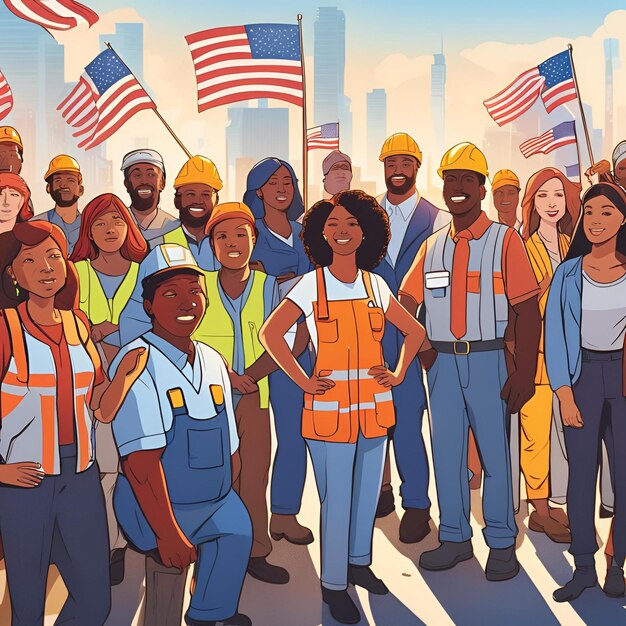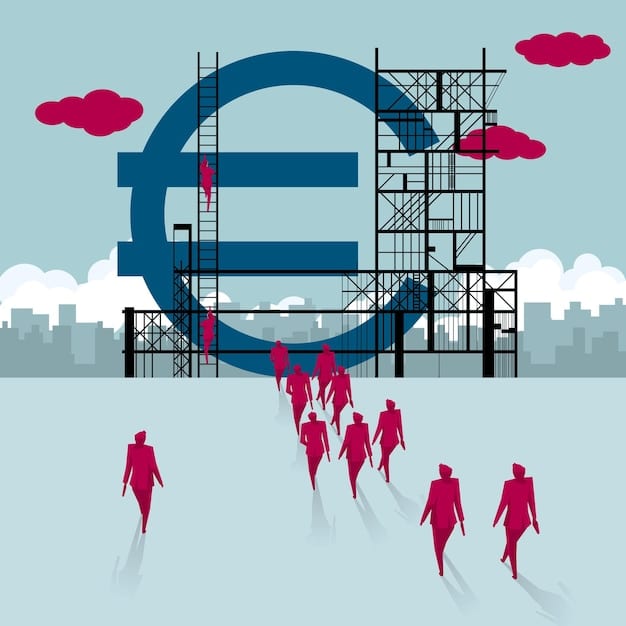Immigration Policy Shifts: Analyzing the Impact on the US Labor Market

Proposed changes to immigration policy in the US have the potential to significantly reshape the labor market by altering the supply of workers, influencing wage levels, and affecting various industries differently, with both positive and negative impacts anticipated.
The dynamics of the US labor market are intricately linked to immigration policies. Understanding how will the proposed changes to immigration policy affect the US labor market requires a nuanced approach, considering various factors from labor supply to wage levels.
Understanding the Current Immigration Landscape
The current immigration policies in the United States are a complex web of laws, regulations, and executive orders that govern who can enter the country, how long they can stay, and whether they can work. These policies have a direct and profound impact on the US labor market.
Existing Immigration Policies and Their Impact
Existing immigration policies affect various sectors differently. Some policies favor skilled workers, while others prioritize family reunification. The consequences of these policies impact the availability of labor, wage structures, and overall economic productivity.
- H-1B Visa Program: This program allows US employers to temporarily employ foreign workers in specialty occupations.
- Family-Based Immigration: Prioritizes the entry of foreign nationals who have family members already living in the US.
- Employment-Based Immigration: Focuses on attracting workers with specific skills and qualifications.
Current policies also establish quotas and caps on the number of immigrants allowed into the country each year, which can lead to labor shortages in certain industries. Understanding this landscape is crucial before assessing the potential impacts of proposed changes.
Overview of Proposed Immigration Policy Changes

Several proposed changes to immigration policies are currently being considered, ranging from border security enhancements to pathways to citizenship for undocumented immigrants. These changes could drastically alter the composition and dynamics of the US labor market.
Key Proposals Under Consideration
The proposed policy changes cover a wide spectrum of issues, including increasing border enforcement, modifying eligibility criteria for visas, and offering a path to legalization for unauthorized immigrants. These changes could reshape the labor market significantly.
- Border Security Enhancement: Increased funding for border patrol and construction of physical barriers.
- Visa Reform: Changes to the H-1B visa program, potentially raising the minimum wage requirements.
- Pathways to Citizenship: Proposals to grant legal status to undocumented immigrants who meet certain criteria.
The potential consequences of these proposals elicit both strong support and opposition, with analysts debating their effect on economic growth, employment rates, and social welfare. A detailed examination of these changes is essential to assess their potential effects on the labor market.
The proposed changes aim to streamline the immigration process, enhance border security, and address the status of undocumented immigrants. The goal is to create a more efficient and equitable immigration system that aligns with the economic needs of the country.
Impact on Labor Supply
One of the immediate effects of any change to immigration policy is its impact on the labor supply. Changes in immigration levels can influence the availability of workers in different sectors and skill levels.
Changes in the Number of Immigrant Workers
Policy changes that restrict immigration could lead to a decrease in the labor supply, particularly in industries that heavily rely on immigrant labor, such as agriculture, construction, and hospitality. Conversely, policies that expand immigration could increase the supply of workers.
The decrease could result in labor shortages and increased labor costs. Industries dependent on immigrant labor may struggle to find enough workers, leading to production delays and higher prices for consumers.
Alternatively, an increase in immigrant workers could ease labor shortages and potentially lower labor costs. This could stimulate economic activity and benefit consumers.
Ultimately, the impact on labor supply will depend on the specifics of the policy changes and the response of businesses and workers to these changes.
Wage Levels and Income Distribution
Immigration policies also affect wage levels and income distribution across different sectors of the economy. Changes in the supply of labor can influence the balance between labor demand and supply, impacting wages.

Wage Compression or Increase
Some studies suggest that increased immigration can lead to wage compression, where the wages of low-skilled workers decrease due to an increased supply of labor. However, other studies argue that immigration can also stimulate economic growth, leading to increased wages and opportunities for all workers.
Wage compression can exacerbate income inequality, particularly for low-skilled workers who compete directly with immigrants. Policy changes that address income inequality, such as minimum wage increases and job training programs, may be necessary to mitigate these effects.
Conversely, immigration can also bring highly skilled workers who can drive innovation and productivity, leading to higher wages for all workers. By attracting talented individuals, immigration can create new opportunities and boost economic growth.
The net effect on wage levels and income distribution will depend on a variety of factors, including the skill composition of immigrants, the structure of the labor market, and the policy responses to these changes.
Sector-Specific Impacts
The effects of immigration policy changes are likely to vary across different sectors of the US economy. Some sectors, such as agriculture and construction, heavily rely on immigrant labor, while others may be less directly affected.
Agriculture, Construction, and Tech Industries
Agriculture, construction, and technology industries rely on immigrant labor, and changes in immigration policies can have significant consequences for their operations. Understanding the specific impacts on these sectors is critical for assessing the broader effects on the US labor market.
Agriculture
The agricultural sector heavily relies on seasonal immigrant workers for planting, harvesting, and processing crops. Restrictive immigration policies can lead to labor shortages, impacting crop yields and food prices.
Construction
The construction industry also relies on immigrant labor, particularly for physically demanding jobs. Immigration policies that restrict the supply of labor could lead to project delays and increased construction costs.
Technology
The technology sector relies on highly skilled immigrant workers to drive innovation and growth. Changes to visa programs can affect the ability of companies to attract and retain top talent.
The varying impacts on these sectors highlight the need for tailored policy responses that address the specific needs and challenges of each industry.
Potential Economic Consequences
Changes to immigration policies can have far-reaching economic consequences, affecting overall economic growth, productivity, and international competitiveness. Understanding these potential consequences is essential for sound policymaking.
GDP Growth and Innovation
Economic growth and innovation can be significantly impacted by immigration policy changes, with direct consequences for employment rates and overall economic output. These effects need to be carefully evaluated to make informed decisions.
- GDP Growth: Restrictive immigration policies can reduce economic output by limiting the supply of labor and reducing consumer demand.
- Innovation: Immigrants often bring new ideas and perspectives, contributing to innovation and technological advancements.
- Employment Rates: Changes in immigration levels can directly affect employment rates, particularly in sectors that rely on immigrant labor.
The economic consequences of immigration policy changes are complex and multifaceted, requiring a comprehensive and evidence-based approach to policymaking. By considering the various effects on economic growth, innovation, and employment rates, policymakers can make informed decisions that promote economic prosperity.
Policy Recommendations and Mitigation Strategies
To mitigate the potential negative impacts of immigration policy changes on the US labor market, several policy recommendations and mitigation strategies can be implemented. These strategies aim to address labor shortages, wage compression, and other challenges.
Policymakers must consider the specific needs and challenges of different sectors and implement tailored strategies to address these issues effectively.
- Comprehensive Immigration Reform: A pathway to legalization for undocumented immigrants and reforms to visa programs could align with economic needs.
- Job Training Programs: Investing in job training and education programs can equip workers with the skills needed to succeed in a changing labor market.
- Wage Standards: Implement wage standards and protections for low-skilled workers to guard against wage compression.
These policy recommendations and mitigation strategies can promote a more equitable and sustainable labor market, regardless of changes to immigration policies.
| Key Point | Brief Description |
|---|---|
| 📊 Labor Supply | Immigration changes can significantly alter the availability of workers. |
| 💰 Wage Levels | Wage impacts vary, potentially leading to compression or growth. |
| 🏭 Sector Impacts | Agriculture, construction, and tech industries face unique challenges. |
| 🌐 Economic Growth | Immigration policies influence GDP, innovation, and job rates. |
Frequently Asked Questions
▼
Restrictive immigration policies can exacerbate labor shortages, particularly in sectors that heavily rely on immigrant workers like agriculture and construction, leading to production delays and higher prices.
▼
Wage compression refers to the lowering of wages for low-skilled workers due to an increased supply of labor caused by immigration, potentially increasing income inequality.
▼
Agriculture, construction, and technology sectors are significantly affected by changes in immigration policies due to their reliance on immigrant labor for various roles and skill levels.
▼
Job training programs equip domestic workers with the skills needed to fill jobs traditionally held by immigrants, mitigating labor shortages and promoting economic growth.
▼
Restrictive immigration policies can lead to decreased economic output, reduced innovation, and increased labor costs, impacting overall economic growth and competitiveness.
Conclusion
Understanding how will the proposed changes to immigration policy affect the US labor market requires a comprehensive understanding of various factors. With careful consideration of policy recommendations and impact mitigation strategies, the United States can ensure a stable, competitive, and equitable economy.





